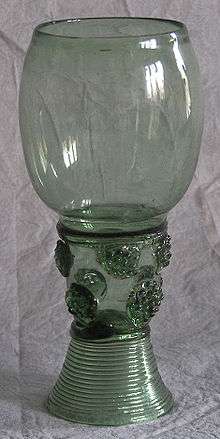Rummer
.jpg)

Rummers, Römers, or Roemers, were large drinking-glasses studded with prunts to ensure a safe grip, popular in the Rhineland and the Netherlands from the 15th through the 17th century. They lacked the flared bowl of the Berkemeyer and had much thinner walls. The hollow base was built up by coiling strands of molten glass around a conical core. Römers were quite distinct from the Berkemeyers, but both types evolved from the German "cabbage stalk" glasses which were cylindrical with prunts. Römers are usually green in colour and with Berkemeyers were sometimes engraved with images and inscriptions.
From as early as the third century, skilled glass workers along the Rhine were producing work of great artistic merit. Excavations at Worms, Treves, Cologne, and in the Eifel revealed glass factories that were probably Roman in origin—indeed, Römer is German for Roman. Ancient Rhenish graves have yielded gilt-decorated bowls and beakers which were made using the fondo d'oro ("base of gold") process in which the design is etched into a layer of gold on the glass surface, and then covered by more glass. These techniques persisted to the fifth century, mythical and biblical themes enjoying great popularity. Out of this era grew that hallmark of German glass, the prunt, a design feature which is still found fifteen centuries later.[1]
References
External links
-
 Media related to Rummers at Wikimedia Commons
Media related to Rummers at Wikimedia Commons - Corning Museum of Glass - Glossary of Glassmaking Terms